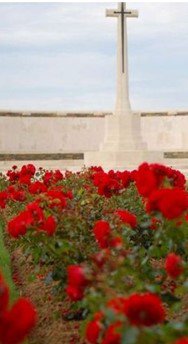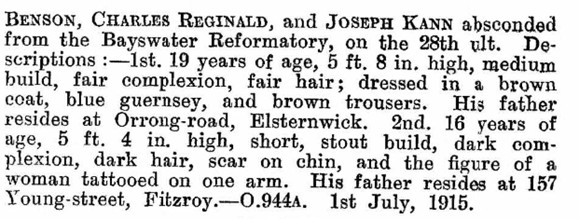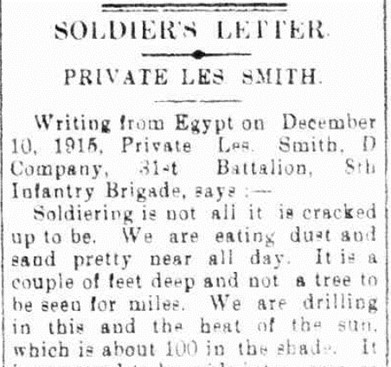Charles Reginald BENSON
Eyes blue, Hair fair, Complexion fair
Charles Benson – A Man with Many Names
Can you help us identify Charles?
Charles Reginald Benson was just 19 years old when he died at Fromelles, France, in July 1916. His story, like many others of the time, is one of hardship, transformation, and sacrifice.
As part of the 31st Battalion he was positioned near where the Germans collected soldiers who were later buried at Pheasant Wood. There is a chance he might be identified, but we need help. We are still searching for suitable family DNA donors.
We need to find family members who are likely to be living in the Melbourne area to help with the family tree and to donate DNA in hopes that Charles’ remains may be able to be identified from the mass grave found at Pheasant Wood. At least three of his sisters were married and had children – Elizabeth (Gartner) – died in Burwood VIC, Lilian (McCracken) – died in Prahran, VIC and May (Parker) – died in Aramadale, VIC.
In 2008 a mass grave was found at Fromelles, a grave the Germans dug for 250 (Australian) bodies they recovered after the battle.
If you know anything of contacts for Charles here in Australia, please contact the Fromelles Association.
See the DNA box at the end of the story for what we do know about his family.
Early Life
Charles was born in Malmsbury, Victoria, in 1897 to George Benson and Mary Owens. He was the youngest of a large family. His older surviving siblings were Elizabeth, Mary, Lilian, May, Eva, Gladys and Doris. Two sons and one daughter had died when they were young. Charles did his schooling at the All Saints Grammar School. Unfortunately, Charles’s early life was troubled.
He was involved in a series of arrests for theft when he was 18 and in April 1915 was sent to the Bayswater Reformatory for three years. The Bayswater Reformatory operated under the Department of Neglected Children and Reformatory Schools. While in the institution, boys were subject to strict discipline, labour, and in some cases harsh treatment, as was common for state care facilities in that era. His stay was only short, however, as he and a mate escaped in early July.
Soon after he escaped, he joined the Army, although under the false name of Charles Frederick Harrison. He stated he was 21, gave his occupation as carpenter and listed his next of kin as David Harrison of Malmsbury. It was not uncommon for young men with troubled backgrounds or estranged family relationships to enlist under aliases, often to start fresh or avoid legal complications. (Note, his AIF file also has records of a Charles Finley Harrison (2900), but with markedly different height and weight.).
Charles’ father signed a statutory declaration in 1918 that Charles was indeed Charles Reginald Benson. While Charles seemed to have been on a rough start before enlisting, he had no reportable offences as a soldier.
Off to War
Charles was allocated to the newly formed, 31st Battalion C Company and he began his military training at the at Broadmeadows Camp outside of Melbourne. The 31st was made up of two companies from Victoria and two from Queensland. The full battalion came together in early October at Broadmeadows in Victoria.
Before sailing from Melbourne on 9 November aboard the troopship Wandilla, the 991 soldiers of the 31st had been on parade in Melbourne in front of a good crowd. The Minister for Defence, H.F. Pearce said “I do not think I have ever seen a finer body of men.”
Source: INFANTRY MARCH PAST (1915, November 6). Weekly Times (Melbourne, Vic. 1869 - 1954), p. 32. http/nla.gov.au/nla.news-article132708935
The Wandilla docked at Port Suez, Egypt almost exactly four weeks after leaving Melbourne. They were first sent to the camp at Serapeum to continue their training and to guard the Suez Canal from any potential threats posed by the Ottoman Army. Near the end of February they moved to the large camp at Tel-el-Kebir, which was about 110 km northeast of Cairo. The 40,000 men in the camp were comprised of Gallipoli veterans and the thousands of reinforcements arriving regularly from Australia. The 60 km trip must have been unpleasant, as it was reported that they were moved in “dirty horse trucks”’.
Source AWM4 23/48/7, 31st Battalion War Diaries, Feb 1916, page 5
The next move was at the end of March, back to the Suez Canal at the Ferry Post and Duntroon Camps and then finally to Moascar at the end of May. The months passed in training and sightseeing, but by the time the 31st Battalion was transferred to France, the men were all heartily sick of Egypt. Private Les Smith’s (934) letter home pretty well sums it up.
On 15 June, the 31st Battalion began to make their way to the Western Front, first by train from Moascar to Alexandria and then Charles' C company boarded the troopship Manitou, sailing to Marseilles. After disembarking on 23 June, they were immediately boarded onto trains for a three-day trip to Steenbeque and then marched to their camp at Morbecque, 35 km from Fleurbaix in northern France, arriving on 26 June. The battalion strength was 1019 soldiers.
Fromelles
The area near Fleurbaix was known as the “Nursery Sector” – a supposedly relatively quiet area where inexperienced Allied troops could learn the harsh realities of Western Front trench warfare against the Germans. But the quiet times and the training period did not last long. Training continued, now with how to handle poisonous gas included in their regimen. They began their move towards Fromelles on 8 July and by 11 July they were into the trenches for the first time, in relief of the 15th Battalion.
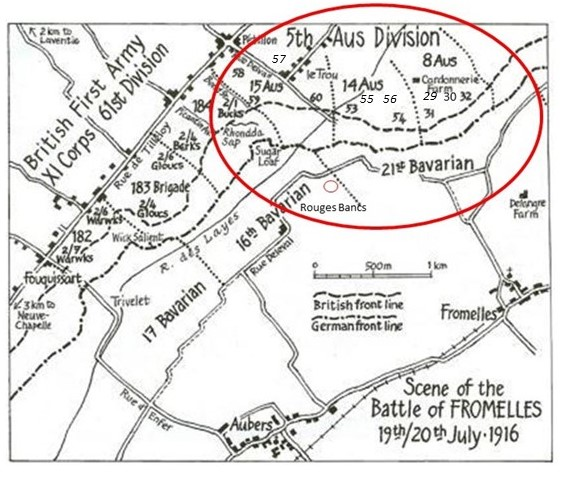
The main attack was planned for the 17th, but bad weather caused it to be postponed. On the 19th they were back into the trenches and in position at 4.00 PM and the Zero Hour for advancing from their front-line trenches was to be 5.45 PM. However, the Germans knew this attack was coming and were well-prepared.
“Just prior to launching the attack, the enemy bombardment was hellish, and it seemed as if they knew accurately the time set.”
The assault began at 5.58 PM , going forward in four waves, A Company and Charles’ C Company in the first two waves and B and D Companies in the 3rd and 4th waves. There were machine guns emplacements to their left and directly ahead at Delrangre Farm and there was heavy artillery fire in No-Man’s-Land.
The pre-battle bombardment did have a big impact and by 6.30 PM the Aussies were in control of the German’s 1st line system (Trench B in the diagram below), which was described as “practically a ditch with from 1 to 2 feet of mud and slush at the bottom.”
Source AWM4 23/49/12, 32nd Battalion War Diaries, July 1916, page 11

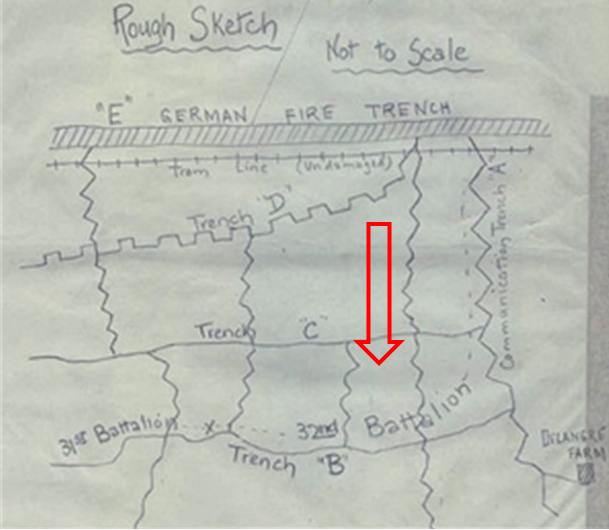
Unfortunately, with the success of their attack, ‘friendly’ artillery fire caused a large number of casualties. By 8.30 PM the Australians’ left flank had come under heavy bombardment with high explosives and shrapnel. Return bombardment support was provided and the 32nd, who also had the job of holding the flank to the left of the 31st, were told that “the trenches were to be held at all costs.”
Source AWM4 23/49/12, 32nd Battalion War Diaries, July 1916, page 12
Fighting continued through the night. The Australians made a further charge at the main German line beyond Trench B, but they were low on grenades, there was machine gun fire from behind from the emplacement at Delangre Farm and they were so far advanced that they were getting shelled by both sides.
At 4.00 AM the Germans began an attack from the Australian’s left flank, bombing and advancing into Trench A (map). Given the Australian advances that had been made earlier, portions of the rear Trench E had been left almost empty, which then enabled the Germans to be in a position to surround the soldiers.
At 5.30 AM the Germans attacked from both flanks in force and with bombing parties. Having only a few grenades left themselves, the only resistance the 31st could offer was with rifles:
“The enemy swarmed in and the retirement across No Mans’ Land resembled a shambles, the enemy artillery and machine guns doing deadly damage.”
The 31st were out of the trenches by the end of the day on the 20th. From the 1019 soldiers who left Egypt, the initial impact was assessed as 77 soldiers were killed or died from wounds, 414 were wounded and 85 were missing. To get some perspective of the battle, when Charles Bean, Australia’s official war historian, attended the battlefield two and half years later, he observed a large quantity of bones, torn uniforms and Australian kit still on the battlefield.
The ultimate total was that 161 soldiers were either killed or died from wounds and of this total 82 were missing/unidentified. The bravery of the soldiers of the 31st was well recognised by their own Battalion commanders.
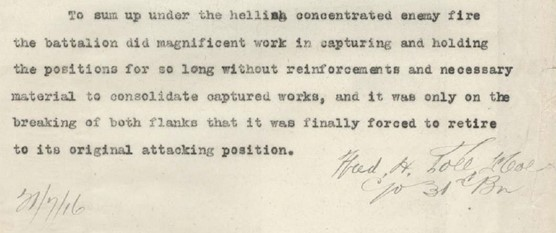
Aftermath
Charles was initially listed as among those missing in action, but there are no witness statements about where he might have been during the battle. The Army did undertake thorough searches of hospitals, POW camps, etc, but Charles remained ‘missing’. It was not until a Court of Enquiry held on 1 August 1917 — more than a year later — that he was officially declared killed in action, but his date of death was recorded as 21 July 1916.
His obituary was listed in the papers on 21 August 1917.
DIED ON SERVICE
Benson – Killed in action, 21st July, 1916 (previously reported missing), Private Charles Reginald Benson, only son of Mr. and Mrs. George Benson, Orrong road, Elsternwick, aged 19 years.
Charles was awarded the 1914-15 Star Medal, the British War Medal, the Victory Medal, a Memorial Plaque and a Memorial Scroll. He is commemorated at the Australian War Memorial, Canberra.
Several Issues Remain
First, where is Charles?
While ‘missing’, there is an undated, handwritten note in his AIF file that states he was buried, but it gives only a very general map reference.

There are similar notations for 21st C Company soldiers, indicating that at some time the Army may have gained information on the burial of these men by the Germans, but there is no further documentation available.
Second, why is his death noted as 21 July?
From research done about 100 years after the battle, it was found that 'C' Company appeared to be the only Company to furnish casualty records that have 21 July recorded as their date of death – for a total of forty-three soldiers. While it is uncertain as to why this was done, it likely reflects when the recording of the information was done, rather than the date of death. This was not corrected at the time, but has been revised to 19-20 July 1916.
Further, why was he not commemorated at either at VC Corner Australian Military Cemetery nor at the Australian National Memorial at Villers-Bretonneux? Only those soldiers whose date of death was listed as 19 or 20 July were initially placed of the wall at VC Corner and others were supposed to be at Villers-Bretonneux. Several soldiers have the same issue of not being included at either memorial. It is being dealt with by the Office of Australian War Graves, Commonwealth War Graves Commission.
Could Charles Still Be Found?
To date (2024), 23 of the missing soldiers from the 31st have been identified by DNA testing from the bodies in the mass grave the Germans dug at Pheasant Wood that was discovered in 2008. Further, 4 of the 21 C Company soldiers with ‘buried’ in their file have been found at Pheasant Wood.
A total of 70 of the 250 soldiers found in the grave remain unidentified. Charles could well be among the remaining unidentified soldiers, but we need to find family DNA donors to see if he could be identified and given proper recognition. If you have any information about Charles’ family, please contact the Fromelles Association.
DNA samples are being sought for family connections to
| Soldier | Charles Reginald Benson (1897-1916) |
| Parents | George Benson (1852-1958) Mary Owens (1852-1938) |
| Siblings | Elizabeth (1875–1953) b Malmsbury VIC, d Burwood VIC, m Wm Henry Gartner, children | ||
| Mary (1878– ) | |||
| Lilian (1884–1974) b Malmsbury Vic, d Prahran VIC, m Wm McCracken, children | |||
| May (1885–1974) d Aramadale VIC, m George Parker, children | |||
| Eva (1887–1975) b Prahran VIC | |||
| Gladys (1890–1949) b St. Kilda VIC, d Toorak VIC | |||
| Doris (1893–1970) b Malmsbury VIC, d Caulfield VIC |
| Grandparents | |||
| Paternal | John Benson (1810–1876) and Catherine Mary Ryan (1818–1902) | ||
| Maternal | John Owens and Catherine Arnold |
Seeking DNA Donors

Contacts
(Contact: carla@fromelles.info or geoffrey@fromelles.info).
(Contact: army.uwc@defence.gov.au or phone 1800 019 090).
Donations
If you are able, please contribute to the upkeep of this resource.
(Contact: bill@fromelles.info ).
